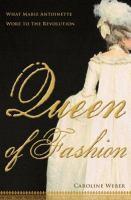
From the masculine equestrian outfits that made her Louis XV's favorite, to the regal counterrevolutionary gowns in green and violet that exposed her as an enemy of the state, Marie Antoinette's fashion statements were always unfailingly both fabulous and controversial. In Queen of Fashion, Caroline Weber paints a comprehensive portrait of the fashion icon, from Dauphine until death. Weber is not only a brainy Barnard scholar, but also a fashion connoisseur herself, and her fastidiously researched political fashion memoir satisfied both my inner Vogue subscriber and my inner history nerd.
Anyone who's watched Sofia Coppola's film Marie Antoinette as many times as I have can easily rattle off the basics of her biography: born an Austrian, Marie Antoinette disavowed her native country in a political alliance with France to become its eventual Queen. A newcomer to the highly ritualized and chic court at Versailles, she navigated her tepid political reception as a suspect foreigner in the best way she knew how -- in impeccable style. And although it all started out as fun and games, eventually it cost the Autrichienne her head on the guillotine. From her powdered, sky-high hairdos to her divine selection of costly satin footwear, Marie Antoinette won over her adoring public at first, but quickly became a lightning rod for criticism of the French monarchy’s decadence during a national economic recession (... sound familiar?).
Weber takes her time cataloging the earlier, more playful era of Marie Antoinette’s youthful fashion exploits: her androgynous redingotes ("riding coats") and her architectural "poufs" that popularized towering ladies' hairstyles in commemorative shapes such as naval ships and gigantic birds in flight. Did you know that legislation was introduced to raise the standard height of a Parisian doorway to accommodate the hairstyles' extra footage? But these playful themes take a somber--albeit fascinating-- tone in the latter half of Weber’s book, as she traces the onslaught of political tumult through the headwear of the ladies of Paris. From the hat "au collier de la Reine" that signaled disapproval of Marie Antoinette’s role in the scandalous Diamond Necklace Affair, to the bonnet "a la Bastille" that celebrated the pivotal revolutionary prison-siege, to the royalist "coiffure a la Reine" that belied fatal counterrevolutionary monarchist sympathies, Parisian women expressed the changing political tides via what they wore on their heads.
Page after page, Caroline Weber captivated me with arcane facts and insights into the symbolic weight of ladies’ fashions during a period of political upheaval. As a scholar first and fashionista second, she drew me into the political saga of the French Revolution, but always faithfully brought it right back around to fashion and the ways women--especially Marie Antionette--leveraged their power by what they chose to wear on their bodies. Ultimately, Marie Antionette was the consummate 'Fashion Victim,' and ended her life with "the most brilliant fashion statement of her political career." What was it? You’ll have to read the book to find out!
